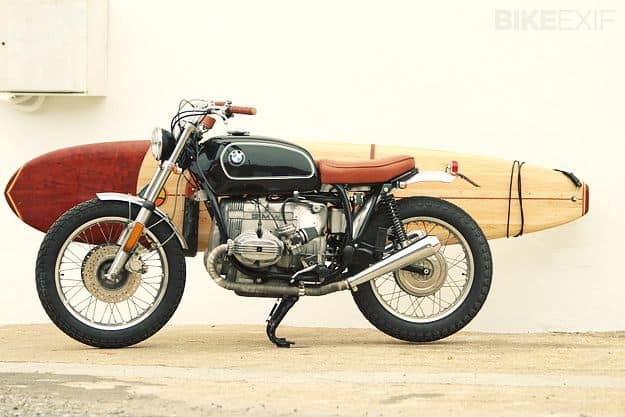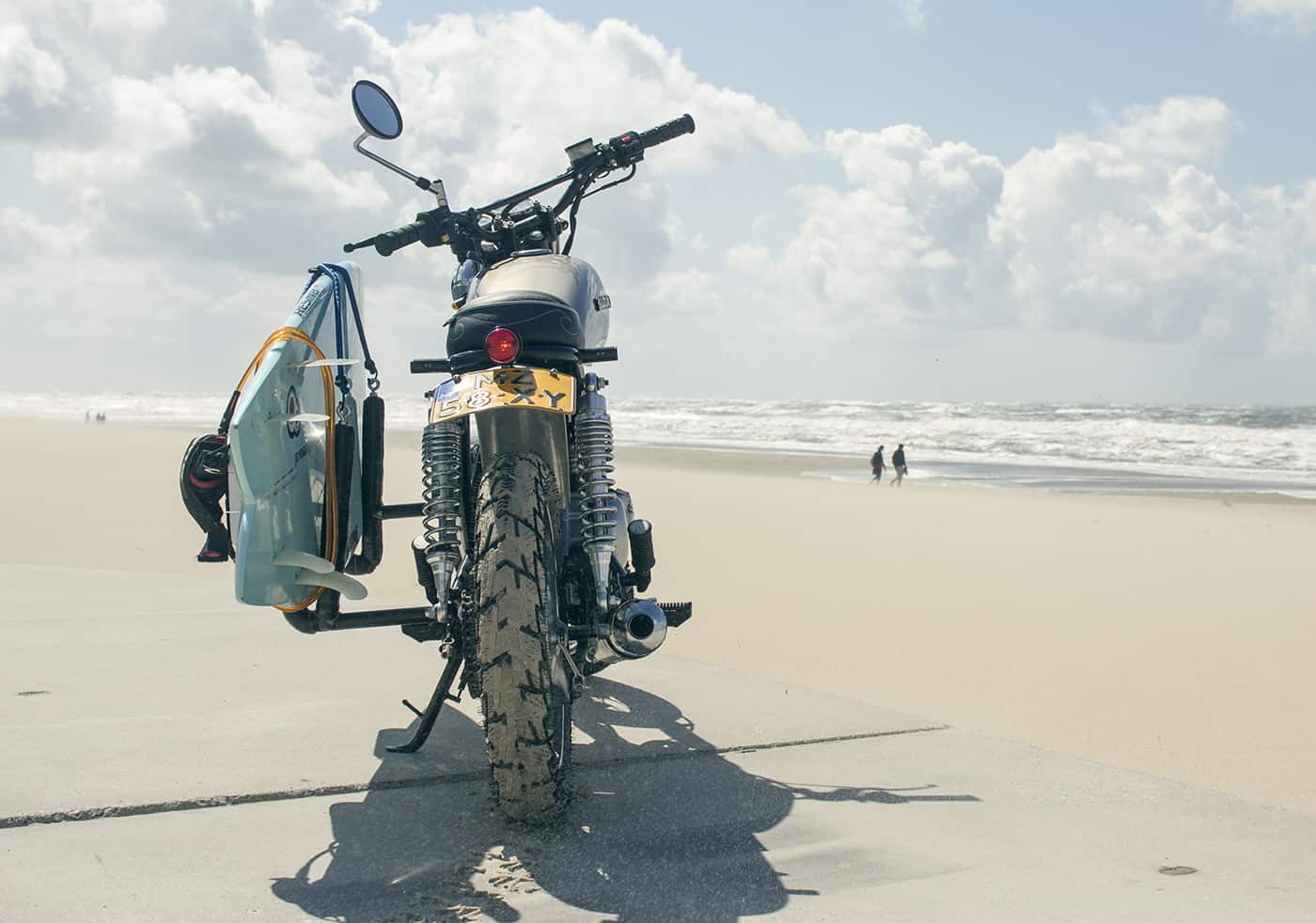For motorcycle riders, there’s nothing like the freedom of the open road. Unless of course you’re a motorcycle rider and a surfer.
Fulfilling the dream of taking a road trip down the coast on your bike with board in tow, visiting all the best surf spots is a dream for many surfers.
But before you can embark on your journey, whether a road trip or just down the street to your local break, you have to figure out how to attach your board to your bike. Thankfully surfboard racks exist, but are they even legal for motorcycles in the U.S.? While you should check with your state and local laws, in general, surfboard racks are legal on motorcycles and will not pose a problem in your state.
State laws can vary, so it’s best to check with your specific area, but generally surfboard racks are legal attachments to a motorcycle in the United States.
Carrying surfboards and using surfboard racks are not specifically mentioned, but fall under the guidelines of load carrying. What the motorcycle laws do say, is that it’s legal to carry cargo on your motorcycle as long as it doesn’t impede your ability to safely ride.
So, as long as you can safely ride with your surfboard, you can carry it as cargo on a board rack while riding a motorcycle. There are though, specific laws about how to carry cargo safely as well as different kinds of racks to consider.
Rules for Carrying Your Board
When it comes to riding a motorcycle, Vespa or moped, there are certain laws regarding how to carry cargo and rules to follow in order to do it safely.
This makes it important to consider how safely you can ride with your surfboard attached to your bike and also how far or where you’re traveling.
It’s not suggested to ride over 55 mph when carrying something like a surfboard as they can make it harder to drive on the freeway. Strong winds can throw a rider off balance when hitting your board causing you to drift lanes or wobble.
However, when properly attached, many people are able to ride at normal highway speeds. Much of it has to do with your board, your setup and your confidence driving a motorcycle.
When it comes to setup and how to carry a surfboard, the law has several requirements. Again, while there isn’t specific mention of surfboards, there are guidelines and rules to follow regarding load carrying.
Loads must be kept low, as cargo will shift the center of gravity on your bike. Cargo must be kept forward, over or in front of the rear axle as loading behind it affects turning, braking and may create a wobble.
Weight should be evenly distributed as an uneven load can cause drifting from side to side. Cargo must be securely attached with bungee cords or nets.
And lastly, when carrying cargo you must stop frequently to check and make sure nothing has come loose and everything is still securely attached. All these requirements allow for safe travel for yourself and others.
These rules may limit what kind of board you can carry as longer boards may be too big to attach safely. However, if you’re ready to bring your board on your riding adventures, securely attaching it is key.
How to Safely Carry Your Surfboard
When it comes to riding with your board, safety is crucial. You already know the rules about carrying cargo so now you need to securely attach your board to your bike.
If you’ve ever seen someone transporting a poorly attached mattress, you know how easily cargo can be ripped off your vehicle by the wind.
First, make sure your surfboard rack is properly attached to your bike. You can have a mechanic professionally install or weld your rack, or you can also DIY if you’re confident in your abilities.
Next is placing your surfboard on the rack. The best way is to place your board with the nose pointed in order to direct airflow over your surfboard to prevent the wind from blowing it out to the side or completely losing it.
Distribute the weight of your board evenly on the rack to prevent any issues with your bike. This may mean placing the board more forward or more back depending on your board.
Invest in strong cords to keep your board tight against your motorcycle. You want to leave just enough room for your leg to fit in and use the footrests.
This again prevents wobbling and drifting by keeping the airflow on the outside of the board as much as possible. Be sure to attach bungees evenly across the board to keep it from wiggling while in motion.
Consider carrying a bag on the opposite side of your bike to help even out the distribution of weight to keep yourself centered. If you have saddlebags, you can use the one on the opposite side of your bike to store other gear like a wetsuit, towel etc.
Practice riding with your full setup around the neighborhood at low speeds before taking it out on the road. Pay attention to the differences in feel and watch out for any signs of your board loosening.
The last thing you need is for your board to fly away while you’re headed to the beach. Not only could it harm someone else, but your board probably won’t survive the fall.
Once you get the hang of riding with your board, you’re all set for the surf.

Types of Surfboard Racks
There are lots of different options when it comes to choosing a surfboard rack. Some of it depends on the type of motorcycle you have and some of it depends on preference.
In general though, board racks aren’t specifically designed for motorcycle use, but rather for bikes in general, meaning bicycles. Going back to safety, this means ensuring whatever type of rack you decide to purchase should be outfitted securely and safely to your motorcycle.
There are three types of board racks, side mount, rear mount and trailer mount. Each has pros and cons to consider when using for a motorcycle.
Side Mount

Side mounts are generally the most popular and safest option when it comes to board racks on a motorcycle. They come with either single or double attachment points and are secured to the side of a bike.
They’re generally easy to install and work with most bikes. They also set weight distribution off balance which needs to be made up for while riding.
Side mount racks are seen as the most secure as your board is tighter against the bike and since your board is pointed in the same direction as the wind, it’s less likely to blow away.
Rear Mount
Rear mounts attach to the back of a bike. They provide better central balance as weight is distributed through the center versus on either side. However, this choice doesn’t fit all bikes and works best with smaller boards.
This option is also tricky when it comes to attaching to a motorcycle as your dimensions width wise will change. Something you’ll need to be aware of while traveling.
This type of mount also creates wind resistance which can cause your board to blow off or for you to be thrown off balance.
Trailer Mount
Trailer mounts are wheeled devices that attach to the back of your bike. Trailer mounts take your board off the bike completely and allow you to tow it behind you.
These are a good option for people with longer boards or stand up paddleboards. They also add length to your motorcycle which again will be something to stay aware of while traveling on your motorcycle.
Trailers also have different regulations when it comes to carrying cargo, so you should double check your local laws. Trailer mounts are generally the least popular option.
When choosing the type of rack you’re going to use, it’s important to take a few points into consideration.
Where will you be riding on your bike? Is this mount for a long road trip up and down the coast, for freeway riding on the way to the beach, or for local roads at low speeds?
What size board do you have? Is it a short board or a longboard and how does it fit in relation to the length of your motorcycle?
Lastly, what is your comfortability when it comes to riding and how will each type of mount affect that comfortability?
Your mount choice will vary depending on your specific situation. Ask other motorcycle riders or surfers what they’re preferences and experiences are using board racks for their bikes.
Related Questions
Can You Make Your Own Surfboard Rack?
Yes, you can make your own surfboard rack, but it can be tricky and it’s important that your rack is strong enough to support your board and the speeds you’ll be traveling.
In order to build a rack you need PVC pipe, hose clamps, PVC glue, pipe insulation, bungee cords, a drill, hacksaw and screwdriver. Make sure your bike has the ability to attach a rack before attempting to build your own.
How Do You Transport a Surfboard Without a Rack?
Transportation will vary depending on the vehicle you’re using to travel. On a car, a board can be attached using roof straps, bungee cords, or ropes.
Place your board bottom side up on the roof and wrap your ropes through the open windows to secure. Or simply store it inside your car, or in the bed of your truck.
On a bicycle, you can carry your board under your arm, although this can be tiring or heavy.
On a motorcycle or scooter though, the only option is to attach a rack as you need control of both hands.


